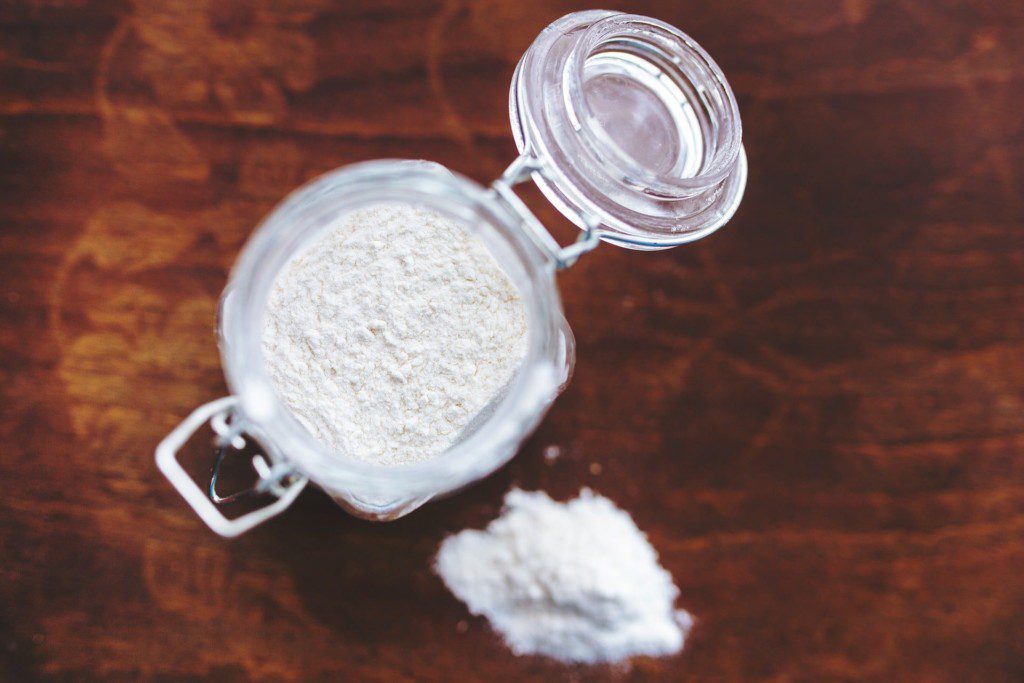Ever wondered what all those code-like names are on an ingredient list on a product label? Most additives are identified by a code number, code name or a chemical name on the back of a product label. One of them being, Acetylated Distarch Adipate or E1422. Acetylated Distarch Adipate (E1422) is popularly known as thickener 1422 (which is the additive code name) that finds application in food as a bulking agent, stabiliser, and thickening agent. It is a vegetable gum that might come bleached with acetic acid.
Thickener 1422 is found in umpteen food types ranging from baby foods, confectionery, jelly type sweets, iced lollies, wine gums, yogurts, fruit-flavored fillings and batter mixes to egg white mix. Let us have a look at the details of this product.

Table of Contents
Physical Properties of Thickener 1422 or Acetylated Distarch Adipate
There are specific properties of acetylated distarch adipate or Thickener 1422 (E1422) that make it distinct. This bulking agent is an odorless powder that appears white or light yellow. With a moisture content of 18 percent at the maximum, it exhibits 88 percent whiteness having an ash content of 1 percent. The pH value of acetylated distarch adipate or thickener 1422 (additive code) is 4.5~8.0. It is highly transparent and has high viscosity. It is highly resistant against not only heat and acid but also against sugar and salt.
Amazon Brand - Vedaka Whole Jeera (Cumin), 200g
₹125.00 (as of March 18, 2025 09:57 GMT +05:30 - More infoProduct prices and availability are accurate as of the date/time indicated and are subject to change. Any price and availability information displayed on [relevant Amazon Site(s), as applicable] at the time of purchase will apply to the purchase of this product.)Related Reading:
Everything you need to know about INS 1442.
Benefits of Acetylated Distarch Adipate Or Thickener 1422
One reason why acetylated distarch adipate or Thickener 1422 (E1422) is used in an array of products is its benefits. Here we are with some of the standard advantages of using this bulking agent:
1. Enhances shine
As acetylated distarch adipate or thickener 1422 is highly transparent, therefore it enhances the shine of the product. It adds luster to the products, thereby making them aesthetically more appealing.
2. Offers stability
Owing to its high viscosity, it exhibits impressive thickening ability. The marvelous low-temperature stability that it offers is another advantage of thickener 1422.

3. Highly useable
Its high resistance against acids, sugar, and salt makes it all the more useful. Apart from this, it is also highly resistant against heat as well as mechanical processing. This means that it finds use in plenty of food products without rendering them a threat to human health.
4. Cost-effective
It reduces colloid usage, thereby enhancing cost-effectiveness.
5. Highly compatible
Last but not least, it is easily compatible with other types of thickeners, thereby ensuring full usability.
Related Reading:
INS 412 – A natural food additive. Know everything about it.
Safety and Caution
Thickener 1422 or acetylated distarch adipate is one of the safest thickeners or additives that are present in various food products. There are no potential threats caused due to use of thickener 1422. However, it is known to have side effects for those who have asthma.
In addition to this, because some starches, for example, corn can be modified genetically, there are chances that some concerns might arise. According to research, it might also be a cause of diarrhea. To some people, it can be a cause of irritation and low-level toxicity.
Some people may have certain reactions that can occur due to allergies. These reactions could be severe depending on the person’s immunity to deal with it. Sometimes people may be sensitive to these additives, so skin reactions could be possible.
Skin reactions can be severe if not taken care of. Therefore, it is a suggestion that you must use it with caution. Another thing that you must keep in mind is that you must avoid giving babies products that contain this food additive.

Uses of additives like thickener 1422 or acetylated distarch adipate
It finds use primarily in foods like frozen cakes, toppings and sauces, dry mixes (cupcakes, muffins, cakes, cookies, and self-saucing puddings), breakfast cereals, mayonnaise, custard powders, and salad dressings. In addition to this, it also finds use in soups, ketchup, vegetable, and meat sauces. Fruit concentrates, jams, marmalades, jellies, marmalades, jellies, and purees, desserts, whipped creams, pies and fillings, and instant beverages, fermented milk, drinking yogurt, flavored kinds of milk, pre-cooked kinds of foods like pasta and noodles, sausages, meatballs, fish balls.
Preparation of Acetylated Distarch Adipate
There are plenty of ways to prepare Thickener 1422. The composition consists of treating native starch either physically, enzymatically, or chemically to change the properties of this native starch.It is made by treating starch with an acetic acid anhydride and adipic acetic anhydride. The starch that results is comparatively high instability and has a low temperature.
Also, it is highly resistant to acids. Modified starch finds application in practically all the uses of carbohydrates, including food products in the form of a thickening agent, stabiliser, or an emulsifier. It is often used in the pharmaceutical industry as a dis-integrant and as a binder in the coated paper.
How to store thickener 1422 or acetylated distarch adipate?
There is an on-going debate about the correct ways of storing food additives like thickener 1422 or acetylated distarch adipate. Saving thickener 1422 is not a complicated process. It would help if you stored it in a spotless place.
Another thing that you must keep in mind is that additives like thickener 1422 or acetylated distarch adipate must not come in contact with moisture. Thus, it would help if you stored it in a dry place. Ensure that the site or a warehouse where you store it has excellent ventilation. It is also essential to maintain an ambient temperature, and keeping it away from odorous materials is a must.
Conclusively, there are a plethora of advantages as well as uses of food additives like thickener 1422. However, one must not forget that appropriately using thickener 1422 is vital as it does have some downsides associated with it.
Thickener 1422 enhances not only the appearance but also the stability and texture. Not to forget, thickener 1422 plays a pivotal role in improving the taste, shelf life as well as diverse other characteristics of different food products.
Related Reading:
INS 415 – Xanthan Gum. Know here everything ranging from drawback and benefits to the products it is added to.
Is Thickener 1422 (E1422) Gluten Free?
Most food additives or thickeners are derived from wheat and wheat starch, which are not gluten free. However, it is said that thickeners from 1401 to 1450 are made from maize, potato starch or tapioca, which are all gluten free.
Why Is Reading Labels Important?
This also brings us to why reading labels and identifying food additives is essential. If you are gluten intolerant, make sure you read the labels thoroughly to ensure if the food product is gluten free. Not only that, some additives, natural colors may cause allergic reactions. Example, a common food additive like MSG or mono-sodium glutamate (621) is strictly prohibited for pregnant women and is said to cause health problems.
INS 300 acidity regulator – What is Citric Acid 330?

Frequently Asked Questions
Here, we have answered a few interesting FAQs about how E1422 is made and what it is used for.
1. What is E1422 made of?
E1422, also known as Acetylated di-starch adipate, is made by treating starch with two chemicals which are acetic acid anhydride and adipic acid anhydride. This treatment results in starch that is resistant to high temperatures and stirring.
2. Is 1422 a preservative?
E1422 is a starch that is modified by acetic acid anhydride and adipic acid anhydride, which is used as a stabilizer, thickener and bulking agent in foods.
3. What is modified starch E1422?
A modified starch E1422 is used in food products as a stabilizer, thickener, and bulking agent.
4. What is stabilizer E1422?
An E1422 finds its application in food as a bulking agent, stabilizer and thickening agent. It is a vegetable gum that might come bleached with acetic acid.
Final Words
Acetylated distarch adipate (E1422), is a starch that is often used in foods as a bulking agent, stabilizer, and a thickener. Its properties like usability, cost-effectiveness, compatibility with other thickeners make thickener 1422 enhances its popularity. However, asthmatic people should take it under medical guidance.
The next time you see thickener 1422 mentioned in a list of ingredients, you know what what you are eating!
Disclaimer – This content including advice provides generic information only. It is in no way a substitute for qualified medical opinion. Always consult a specialist or your own doctor for more information before making any dietary changes.




